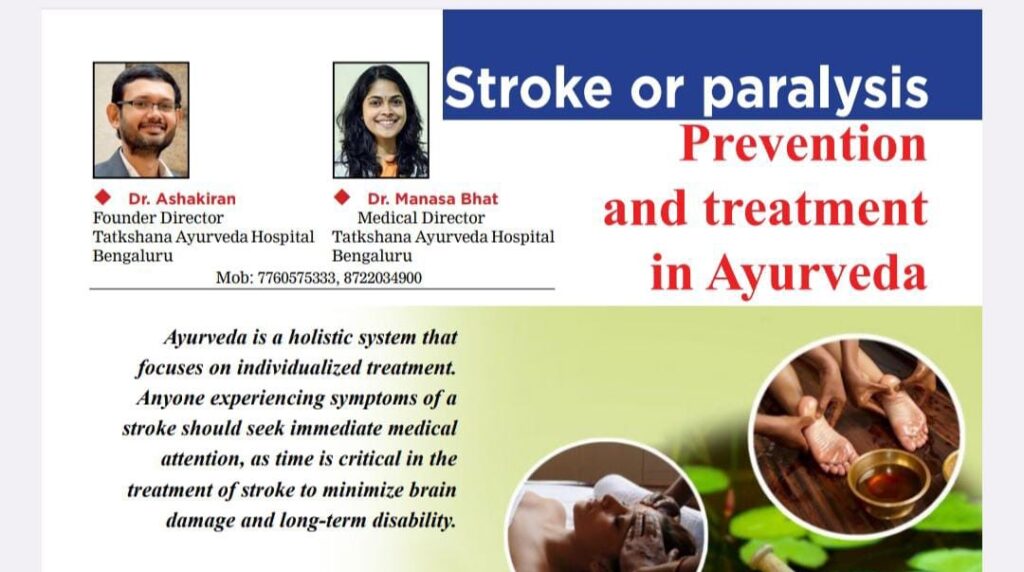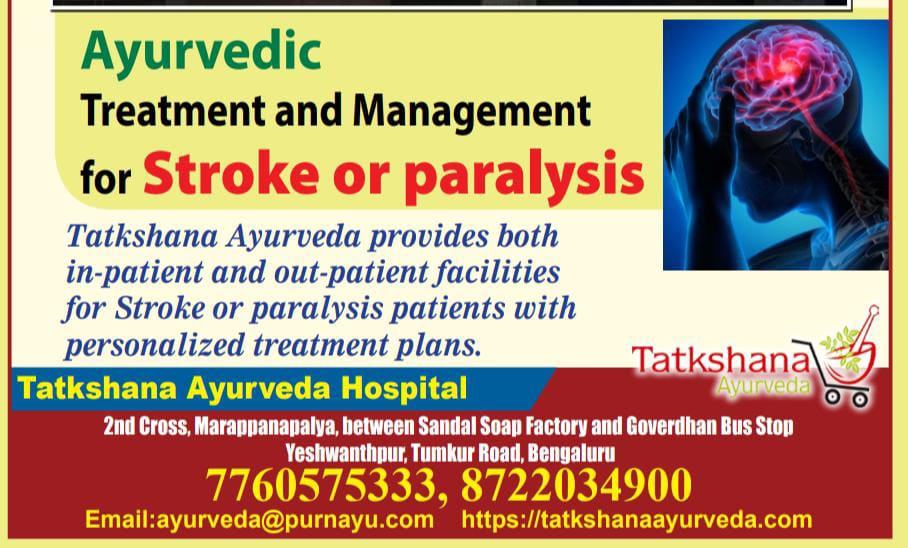Stroke or paralysis Prevention and treatment in Ayurveda, a holistic system that focuses on individualized treatment. Anyone experiencing symptoms of a stroke should seek immediate medical attention, as time is critical in the treatment of stroke to minimize...
Stroke or paralysis Prevention and treatment in Ayurveda, a holistic system that focuses on individualized treatment. Anyone experiencing symptoms of a stroke should seek immediate medical attention, as time is critical in the treatment of stroke to minimize brain damage and long-term disability.

What is stroke?
A stroke (cerebrovascular accident CVA), Pakshaghata in Ayurveda occurs when there is a disruption of blood flow to the brain. This can happen for various reasons, but main categories:
Ischemic Stroke: Common type of stroke, accounting for about 87% of all strokes. It occurs when a blood vessel in the brain is blocked by a clot (thrombus) or a clot that travels from another part of the body (embolus). The lack of blood flow deprives the brain of oxygen and nutrients, leading to damage.
Hemorrhagic Stroke: Occurs when a blood vessel in the brain ruptures or leaks, causing bleeding into or around the brain. It is rare stroke, but often more severe.
Prevention of Stroke or Paralysis:
Manage Blood Pressure: Blood pressure is a significant risk factor for stroke. High BP puts excessive force on the walls of the blood vessels throughout the body, including in the brain. Over time, this damages blood vessel. High BP leads to Atherosclerosis (is the build-up of fatty deposits /plaques inside the blood vessels). These plaques can narrow the blood vessels, reducing blood flow. High BP also damage the delicate blood vessels in the brain. This damage can result in the formation of blood clots or emboli, leading to an ischemic stroke. High BP weaken the blood vessel walls, making them more susceptible to rupture. This can result in a hemorrhagic stroke. High BP often coexists with other risk factors for stroke, such as diabetes, high cholesterol, and smoking. So regularly check your blood pressure and work with your doctor to keep it within a healthy range through lifestyle changes or medication if necessary. Furthermore, it is of utmost importance not to discontinue blood pressure medication or alter the dosage without consulting a medical professional. Research has shown that individuals who cease their blood pressure treatment are at risk of experiencing strokes. Therefore, self-medication should be avoided.
Life style modification: Good sleep is must for proper function of human body. Minimum 6 8 hours of sleep daily is required as it helps to rejuvenate the damaged cells.
Engage in Regular Physical Activity: Sedentary life style is also a major risk factor. Exercise can help maintain a healthy weight, lower blood pressure, and improve overall cardiovascular health. Aim for at least 150 minutes of moderate-intensity exercise per week.
Maintain a Healthy Diet: maintaining a balance between quality and quantity of food is important. A diet rich in carbohydrate, fibre, proteins, vitamins and minerals should be consumed. So including fruits, vegetables, whole grains, and lean proteins can help reduce the risk of stroke. Limit your intake of saturated fats, sodium, and processed foods.
Detoxification: Proper urination and defecation are essential to remove impurities from the blood. This help to regulate blood pressure.
Manage Stress: Chronic stress and emotions can contribute to stroke risk. Find healthy ways to manage stress, such as through relaxation techniques, meditation, or counselling.
Control Diabetes: Individuals with diabetes have an increased risk of stroke. Managing blood sugar levels and maintaining a healthy diet is crucial in preventing stroke.
Avoid Smoking and Alcohol: Smoking and excessive alcohol consumption increase the risk of stroke. Quit smoking and limit alcohol intake to reduce your risk.
Treatment Stroke Management in Ayurveda
Ayurveda states that the origin of diseases, including stroke and high blood pressure, is rooted in Vegarodha, and thus, the key to averting illnesses is:
????: ??????? ??????? ???????? ?????
To maintain good health, it is imperative to heed the natural urges of life: hunger, thirst, sleep, rest, urination, defecation, hiccups, crying, and laughter. These essential bodily functions should proceed unhindered, as obstructing them can lead to adverse consequences.
Conversely, it is advisable to refrain from surrendering to artificial urges, such as eating when not hungry, drinking without thirst, or indulging in these activities for mere entertainment or to please others. Such practices can exert undue stress on the body, potentially affecting the heart and brain.
Treatments
A range of Ayurvedic treatments designed to promote healing includes.
Dhara: medicated oil is steadily poured on the affected body part of the patient.
Nasya: focuse on strengthening muscles, nerves, and circulation above the shoulder area.
Udvartana (Udwarthanam): Dry herbal powders or herbal paste prepared with medicated oils is used in massage
Basti (Medicated Enema): Done in various forms, such as Matra Basti, Anuvasana Basti, and Nirooha Basti. Done for nourishing, strengthening, and stabilizing overall bodily functions.
Ayurveda offers remedies that enhance blood circulation, clear obstructions in the circulatory system, and safeguard neurological health. Herbs like Brahmi and Vacha are known for their neuro-protective properties. Ayurveda employs a systematic detoxification process to optimize digestive function and eliminate Ama, which refers to incomplete digestion and blockages in the body, including the brain.

In some cases, patients may encounter challenges related to the blood-brain barrier, rendering conventional medicines less effective for brain-related issues. However, Ayurveda offers potent solutions. Tatkshana Ayurveda has developed a specialized medication known as Grutha (ghee) that facilitates the transport of medicine to brain cells. Remarkably, Grutha pana, in conjunction with systematic detoxification, has shown significant efficacy in the recovery of patients, even in cases of Facial Palsy.
When it comes to stroke or paralysis, Tatkshana Ayurvedas approach involves thorough nadi pariksha (pulse diagnosis) and extensive discussions with patients to understand their medical history. Based on this, personalized treatment plans are devised. Tatkshana Ayurveda provides both in-patient and out-patient facilities, ensuring comprehensive care for individuals seeking Ayurvedic treatment.

Dr. Ashakiran and Dr Manasa Bhat
Tatkshana Ayurveda
2nd cross, Marappanapalya, B/w Sandal soap factory and Goverdhan Bus-stop
Yeshwanthpur, Bengaluru 560022
Ph: 77605 75333 / 87220 34900
The post Stroke or paralysis Prevention and treatment in Ayurveda appeared first on Health Vision.


